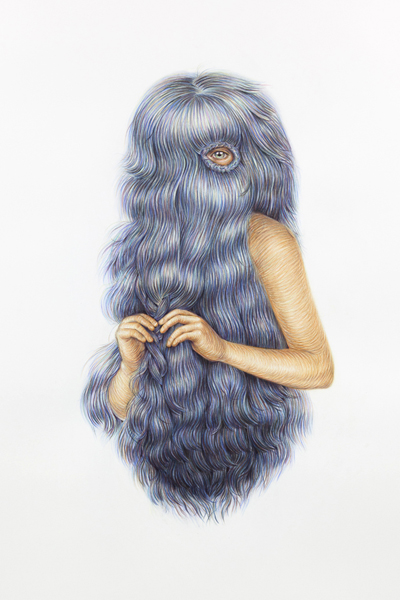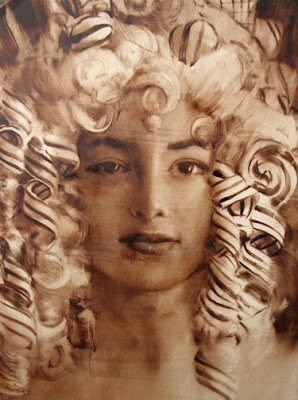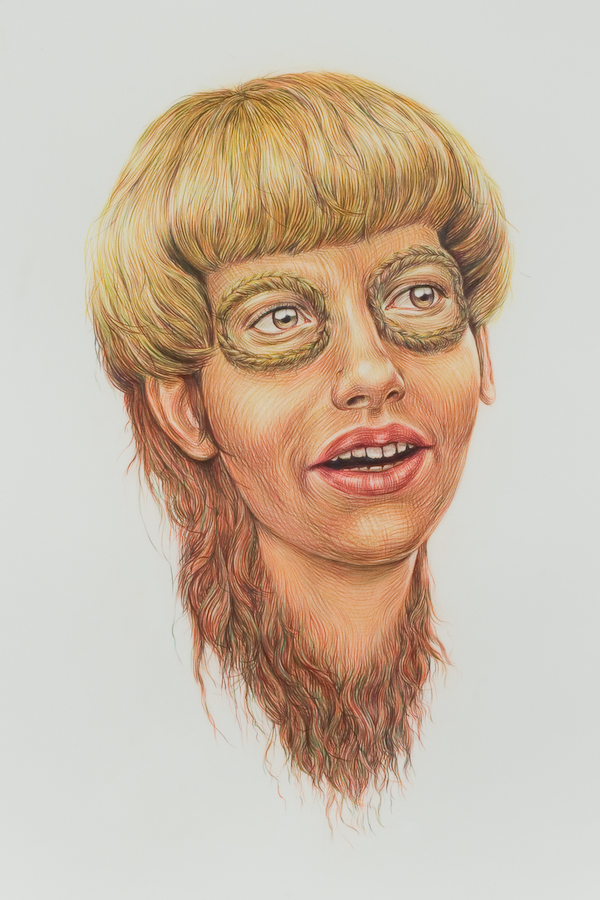LIVING IN HAIRY TIMES - Part I
"I wish my hair was thicker, and I wish my feet were prettier. My toes are really ugly. I wish my ears were smaller. And my nose could be smaller too."
- Britney Spears
- Britney Spears
"I'm undaunted in my quest to constantly amuse myself by constantly changing my hair."
- Hilary Clinton
- Hilary Clinton
"Steinem identified with Holly Golightly from Breakfast at Tiffany’s,streaking her hair like Audrey Hepburn and taking to heart Hepburn’s/Golightly’s line, 'I’ll never let anybody put me in a cage!'"
- Ms. Magazine Blog on Gloria Steinem's Hair Choices
- Ms. Magazine Blog on Gloria Steinem's Hair Choices
 |
| Watchin' Girl - 2011 - Winnie Truong |
 |
| Nice Day for A Sulk - 2011 - Winnie Truong |
"I want it long, straight, curly, fuzzy
Snaggy, shaggy, ratty, matty
Oily, greasy, fleecy
Shining, gleaming, streaming
Flaxen, waxen...
Oh say can you see
My eyes if you can...
Then my hair's too short"
- lyrics from "Hair," from Hair: The American Tribal Love Rock Musical, music by Galt MacDermott, Lyrics by James Rado/Gerome Ragni
 |
| Ornament and Correction - 2010 - Winnie Truong |
Winnie Truong (b. 1988) is obsessed with hair. Or, to better phrase it, she is obsessed with our obsession with hair. Ms. Truong uses the trope of hair in large and small scale drawings, as a multi-leveled metaphor rich with observations about human nature and societal pecking order, with a light yet insistent hand that makes her point. Her work can be seen in New York, New York, through the Mulherin and Pollard Gallery as well as in the ESP Gallery in Toronto, ON, Canada, where the artist also currently works and lives.
Turning a tenacious 23 years old this year, Truong successfully completed her BFA degree at the Ontario College of Art and Design in 2010, one of a graduating class of roughly 500 students. A recipient of the 401 Richmond Career Launcher Award, she won a highly coveted studio for a year, and has been making diligent use of it, flying through multiple shows in Ontario, as well as in the US. She has shown in cities as diverse as New York, Kansas, and Miami. She was in the BMO 1st! Art Group show at the Museum of Contemporary Canadian Art in Ontario, where she was a first place winner for the Ontario area. She has been featured in many online articles, in press and in magazines. She was in VOLTA last year in NYC. She is in the midst of selling her first print series and has just opened a solo show in September 2011 at the ESP gallery. Truong is an avid blogger, she tweets, she tumbles, and she has intelligent things to say about her work. Altogether, Truong is an impressive person, with an already well honed body of work who uses all media and "brand integration" in a way to explore her subject matter that would put many marketing managers to shame.
 |
| Ornament and Correction, showing pencil detail |
By revealing and exploiting humanity's wide range of visual identifiers in her work, primarily through hair, including anomalies and her imagined variations of physical appearance, Ms. Truong explores the intersection of what is considered beautiful, and what isn't. This is the space where her work lives, derives its friction and where it is most successful. Long hair, short hair, beards, side burns, side beards, winged locks, and braids; if it is rooted to a body or a head and is "a cylindrical, keratinized, pigmented filament" Ms. Truong will meticulously render it in her drawings. She also has a thing for pimples, boils and gap teeth. Her palette references the Rococo style's color palette and flourishes while combining comic book art and Japanese animation color schemes in equal stride. After the post impressionism period, the Divisionism's love of color and optical theory is noteworthy and may be influential. At close range, Truong's work melts to tiny repetitive markings, which blend through optic principles as effective today as they were in the 1800s. Color-wheel-wise, her work is wonderful when she explores this painterly nuance beyond expected territory and pushes herself into more difficult color relationships.
 |
| Bride of Dede - 2010 - Winnie Truong |
 |
| Fragonard's Young Girl Reading shows a typical Rococo palette |
Winnie Truong makes her deceptively simple work with colored pencils on stark plain white paper. In each case, the figure ground set-up of head and hair against the blank page are a playground for our imagination and a sea of cultural and historical references to take shape. Winnie Truong's drawings link to artistic influences, social trends and the human history of hair in society and in art. The models are the faces of people chosen at random in fashion and beauty magazines, and perhaps not so haphazard an artistic choice. Due to the magazine source materials, one finds an eerie sense of celebrity in the works, a touch of Emma Watson here, a touch of America Ferrera there, one finds the face of a Calvin Klein model or a famous of-the-moment celebrity actor – Ryan Gosling, or Robert Pattison in the portraits. The people are hard to place, but the faces feel familiar.
 |
| Fringe (Uneven But Promising) -2010 - Winnie Truong |
 |
| More with Less - 2011 - Winnie Truong |
 |
| Fringe Redux -2010 - Winnie Truong |
The figures are strange and like-able, in an awkward, gawky, almost pathetic way, in others the figures seem remote, faceless or more hair than person. Some are cuddly, friendly, or benignly cordial. Some just beam benevolently like from a distant unknown tribe. The best are teenage angsty and absolutely trying for glamour, (a la promtacular) and falling terribly, wrongly, short. However, hair is the subject. Hair, hair, is everywhere.
~ HAIR DEPARTURES - HISTORICAL OVERVIEW ~
 |
| 1700's french hairstyles |
 |
| Glamour and Abscess - 2010 - Winnie Truong |
Hair has an overwhelming history, of course. Since ancient times, when man first understood that hair could be preserved and would not decompose after death, it became a regular part of ritual, personal ornament, and ancestor worship in many communities. As hair has a sensibility that expresses the eerie nature of memory and decay once separated from its lively counterpart, it also has a somewhat morbid aspect to its expression – a dark side. Hair's use in masks, tools, brushes, instruments, and works of art in styles from early human culture in every continent are innumerable. In Egypt, Greece, Rome, China, Japan, Korea, the Northern and Southern Americas, in the Middle East, Africa- the variations implicit in each area's use of hair within various arts, and fashions, for each time period, in specific regions, districts, etc, are too many to be described. It would need to include the entire history of humanity.
Hair can be separated from the body, but it retains a sense of the original person, as witnessed in usage from Santeria to Voodoo to Catholic relics to African ancestral reliquaries. Hair is connected to identity, to our need to indicate social ordering, social codes, and hierarchy, to participate or as a way to stand apart. It presents sexual appeal and attraction, and figures into the hierarchy of beauty codes. It seems throughout time, that what is most attractive is usually the most difficult or expensive to achieve. From the extravagant French fashion images from the 1700's above to the perfectly articulated detailed hair cuts costing thousands by celebrity hair stylists today. Hair has woven itself into our stories and fantasies from the fairy tale of Rapunzel to the Greek myth of Medusa to the Bible's Samson to recent late night TV's Team Coco. Hair care and ornamentation is portrayed in the oldest humans – hair gel was found on preserved ancient bog men (via link) in his unfortunate peat grave, hair ornaments were given to a maiden in a Peruvian sacrifice (via link) and hair details were not forgotten on this elegant Egyptian mummies' hair (via link) (and also below). Hair is integral to human expression – it may be our earliest art form.
This essay will provide an overview of Truong’s oeuvre while also exploring the history of the medium of hair in art and art history. This piece will not seek to provide a thorough or in-depth review of the total history of hair in art. Because Truong’s images trip through time, and touch upon almost every era of history, it has opened a kind of pandora’s box of art historical references. Therefore, by pairing Winne Truong's drawings with art history's references and the similitude of works available from the vaults of time, various bright instants will be matched with our own through the art of one artist.
 |
Medusa - 1595 - by Caravaggio
|
 |
| Queen Nodjmet, 200 BC Egypt, had hair gel in her hair at burial |
 |
| Leonine - 2010 -Winnie Truong |
 |
| detail of Leonine |
~ THE USE OF WIGS IN ART HISTORICAL DEPICTIONS ~
 |
Wig, Ancient Egyptian, Thebes 1500-1300 BC
photo courtesy of the British Museum
|
In depictions of ancient Egypt, wigs were used in daily life. This wig below, dated from between 1500-1300 BC was said to have been found at Thebes, in ancient Egypt, and was discovered in its original 'wig box'. It is unique due to a gold color. According to British Museum Egyptologists, it showed beeswax and resin craftsmanship akin to modern wig-making styles. This wig is thousands of years old, and it still holds together on a wig stand- affirming the extraordinary lasting power of hair. It also reveals the ancient fascination with the blond coloring of hair, and its rarity – enough to preserve it for an upper class Egyptian for the afterlife. Wigs were also sometimes lifted from the head with pads, so Egyptians could feel a breeze beneath the wigs - functioning both as protection from the sun and as venting for airflow. The hypothesis is that wigs prevented heat exhaustion, as well as a chance to change hair for regular cleaning. (A very handy solution to an ancient pre-pesticide world – helping to prevent lice or fleas.) Researchers also believe that Egyptians of the BC era were not as interested in a pretense that the wigs were their "real" hair, in a way that is very similar to the towering wigs of the late 1700’s France. In many images from the period, there are clear demarcation lines that show real hair lines and the wig lines – revealing the wigs were a costume used as a fashion statement and response to social codes of the time. An interesting image below shows a servant presenting offerings to a group. All wear what archaeologists believe are cones with wax and incense that would melt slowly through the evening with the heat - keeping wearers perfumed.
Romans’ wealthiest women had the help of ornatrix, or a personal slave dedicated just to hairstyling. Wigs and towering heights of hair were worn in fashionable or prosperous times such after 1st - 2nd century AD. It is ironic that so much time, effort and money was spent on hairstyling, despite the simple ‘stola’ that high society women wore – which was to emphasize the Roman woman’s sense of modest matronly values.
 |
| Portrait of a woman, wearing Stola, 90-100 AD found in tomb in Alexandria in Egypt |
The stola was the simple dress Roman women began wearing after marriage (normally worn over a tunic.) It was made of wool, and in the small cameo above it is the simple gown with braided straps. Another statue from the time, is of a young girl – whose wig is worn literally above her own hair. The girl also wears a tunic covered by an unadorned palla - or shawl which is loosely wrapped around her. The chasteness of the garments is to show the virtues of the values the wealthier classes maintained despite their social status.
 |
| Young Roman Girl, 210-230 AD |

| ||
| Possibly Julia, daughter of Titus, 80-90s A.D. Rome, Capitoline Museums, Palazzo Nuovo, Hall of the Emperors |
For every Roman, citizenship and the participation as part of the
republic was of social importance in daily life. Women's tunics or stola
were very simple and clothes had to remain modest to be in keeping with social values of Roman society, one where every citizen was a participant. (One empress nursed slaves' infant sons at the same time as her own royal sons, to encourage their 'brotherly affection,' for example, for the cause of Rome, which they would surely grow up to defend together...) Therefore as times became more luxurious in the
republic, the way that women exhibited their wealth was in more and more complex jewelry and
hairstyles, not in their clothing. Some additional examples of hair styles are below. Wigs figured heavily in the styles, and hair pieces, often made from hair brought in from conquered lands, and sometimes dyed colors, were added to heighten the coils.
 |
| 100 AD |
 |
| 90-100 AD |
 |
| 80-100 AD |
 |
| approx 80 AD |
 |
| Roman woman with slaves, including ornatrix |
As a contrast, these images above are reminiscent of how hard women today work to make their hair, nails, and bodies look effortless, yet they spend hours getting hair highlighted, keratin treated, nails done, and hours of time in the gym only to appear to slink around in jeans, beat up t-shirt, and tennis shoes with skinny bodies and muscled tummies and arms. The hair is one of the most important aspects of the polished female appearance today, with a haircut for even regular women going for over $100. The trend seems to be that hair is to be down, undone, and pin straight. The manufactured, seemingly effortless keritain-treated, Kardashian-ized hair, is like a modern version of the Roman stola. Roman society shielded hosts of vice behind their clean wool stolas that purported matronly virtues.
Today's manicured effortlessness requires a similar kind of purity of appearance, but it is taken to an extreme - and down to the body level thanks to technology - taking away all the kink and curl in every strand of hair to make each woman a carbon copy of another. The Millionaire Matchmaker as a matter of course makes all eligible women straighten their hair before she will match them with dates. Will Cotton’s sugary sweethearts below are possibly our modern versions of these antecedents from earlier days.
 |
| Candy Curls (Study) 2007 Will Cotton |
 |
| Ribbon Candy Rosed 2008 Will Cotton |
 |
| Consuming Folly 2009-10 Will Cotton |
 |
| Ice Cream Venus 2010 Will Cotton |
Continued in Living In Hairy Times... Part II....





Comments